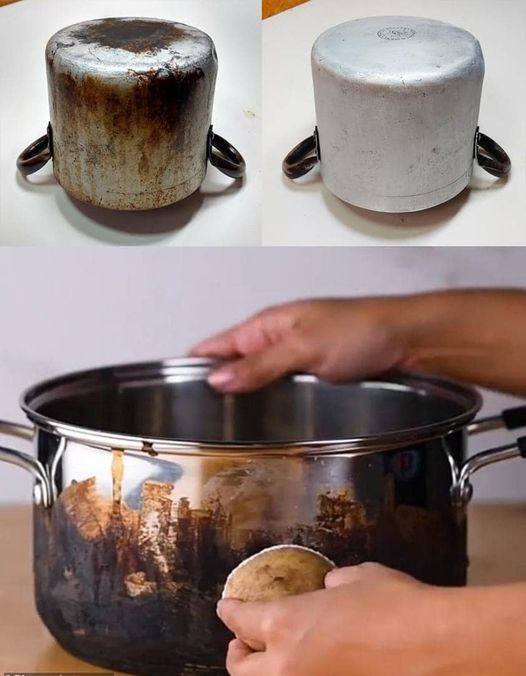Every cook has faced the frustration of burned pots and pans. Whether it’s from a forgotten sauce or overheated oil, those stubborn, blackened stains often seem impossible to clean, no matter how much scrubbing you do. But before you toss that charred pan in the trash or spend hours scrubbing with expensive cleaners, there’s a simple, affordable solution hiding in your kitchen pantry.
Let’s reveal this powerful ingredient and walk through how you can restore even the most scorched pots and pans to their original shine—without damaging the surface.
Why Burn Marks Are So Difficult to Remove
Burnt residues on pots and pans are usually a combination of food particles, carbon buildup, and oils that have cooked beyond their smoke point. As these substances harden and bond to the metal under high heat, they become resistant to standard dishwashing methods. Soap and water alone are rarely enough.
Scrubbing too aggressively, especially with steel wool or abrasive tools, can scratch and permanently damage non-stick coatings or stainless steel surfaces. This is why knowing the right method is essential.
The Secret Ingredient: White Vinegar & Salt Combo
The hero of this cleaning hack? White vinegar combined with salt.
Vinegar’s acidity works to break down the stubborn carbonized layers clinging to your cookware, while salt acts as a natural abrasive without scratching. The combination softens the burnt spots, making them easy to lift off.
Materials You’ll Need:
- Water: Enough to cover the burned area.
- White Vinegar: Around ¼ cup (adjust based on pot size).
- Salt: Two heaping tablespoons.
- Dish Soap: Your regular dishwashing detergent.
- Sponge or Non-Abrasive Scrubber: Avoid metal scouring pads to protect the pan surface.
Step-By-Step Guide to Cleaning Burnt Pots & Pans
1. Fill with Water & Vinegar
Pour enough water into the burned pan to completely cover the scorched area. Add about ¼ cup of white vinegar.
2. Heat the Mixture
Place the pan on the stove and bring the vinegar-water mixture to a boil. Allow it to simmer for 5-10 minutes. This heat plus the acidic vinegar will loosen the burnt-on debris.
3. Add Salt & Let Cool
After simmering, turn off the heat and sprinkle in the salt while the mixture is still hot. Let the pan cool enough to handle safely.
4. Scrub Gently
Using a soft sponge or non-abrasive scrubber, scrub the burned area. You’ll notice the residue lifts away easily, without requiring harsh scrubbing.
5. Wash as Normal
Finish by washing the pan as usual with dish soap and water. Rinse thoroughly.
Why This Method Works
- Vinegar’s Acidity: It weakens the bond between the pan’s surface and the carbon buildup.
- Salt’s Mild Abrasion: It gently scrapes off residue without scratching.
- Heat Activation: Boiling helps loosen the tough, stuck-on particles faster.
Alternative Natural Methods (For Extra Tough Stains)
If your pan needs extra attention, here are a few more tricks:
1. Baking Soda & Vinegar
- After boiling vinegar and water, sprinkle a generous amount of baking soda directly onto the burnt area. The fizzing reaction helps lift stubborn stains.
- Let it sit for 10-15 minutes, then scrub.
2. Lemon & Salt Scrub
- Cut a lemon in half, sprinkle salt onto the cut side, and use it to scrub burnt areas. Lemon’s acidity acts similarly to vinegar and leaves behind a fresh scent.
3. Cream of Tartar Paste
- Mix cream of tartar with a little water to create a paste. Apply to the pan, let it sit for 30 minutes, then scrub and rinse.
How to Prevent Burnt Pots & Pans in the Future
While accidents happen, here are some tips to reduce the risk of burning your cookware:
- Use the Right Heat: Avoid cooking on high heat unless necessary. Medium heat prevents scorching and allows even cooking.
- Stir Frequently: Stirring ensures food doesn’t stick to the bottom and burn.
- Use Oil or Butter Properly: Preheat your pan and add oil before introducing food, to create a non-stick layer.
- Watch Cooking Times: Overcooking is the main culprit of burnt messes—stay attentive, especially when boiling liquids.
When Is It Time to Replace Cookware?
Sometimes, repeated burning or improper cleaning can permanently damage pans. Signs it’s time to replace:
- Warping or uneven heating
- Non-stick coating peeling off
- Permanent black stains that cleaning can’t remove
- Scratches exposing bare metal
Taking care of your cookware ensures a longer lifespan and better cooking results.
Final Thoughts
You don’t need expensive cleaners or hours of elbow grease to tackle burnt pots and pans. A simple, natural mix of vinegar, salt, and a little patience can revive your cookware, saving both time and money. Incorporating these tips into your routine will leave your pots gleaming and extend their usability.

